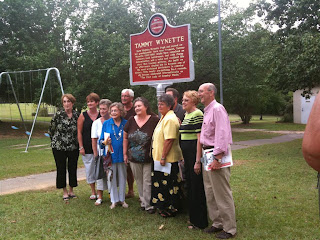From The Itawamba County Times:
One of Itawamba County's oldest living citizens died May 14, 1955 when N. A. Johnson, better known to his hundreds of friends as Uncle Poley, passed away quietly at his home where he had resided all of his life. He lived in the Pine Grove Community. He was 97. Uncle Poley, as he preferred to be called, was born in Itawamba County on January 29, 1858. He had lived in that community in which he has done so much to promote the welfare and died within a mile of where he was born, before the Civil War. He had been an active farmer until his health began to fail about 20 years ago and he just retired to his home with his son, Duie, and daughter, Betty. He died of a kidney ailment which he had at least ten years. He was a charter member of the Pine Grove Church of Christ. Where the Pine Grove Church of Christ stands today is on land that Uncle Poley gave and it was on this land that he was laid to rest. The deceased is not the only member of his family that has lived to an old age. A brother, Billy, lived to be over 90 and another brother, C. S., who is still living is over 90.Funeral services were held May 16, 1955 at the Pine Grove Church with burial in the Pine Grove Cemetery. Pallbearers were Olun Dulaney, Marvin Dulaney, Dow Fikes, Grady Spencer, Clastle Dulaney and Dalton Wilson. Uncle Poley was preceded in death by his wife, Mary Elizabeth Johnson. She died in 1940 and was buried 15 years ago this month.
Survivors included a son, Duie, of the Pine Grove Community, eight daughters, Miss Betty Johnson of the Pine Grove Community, Mrs. Noon Reich, Mrs. Mittie Williams, Mrs. Ollie Tucker, Mrs. Arvella Dulaney, all of the Pine Grove Community, Mrs. Ommie Kurkendall of Fulton, Mrs. Evie Wilson of Fulton and Mrs. Costa Wilemon of Fulton. In addition he leaves a brother, C. S. of Pine Grove and a sister, Mrs. Annie Williams of Pine Bluff, Ark. He also leaves 11 grandchildren, 18 great grandchildren and 3 great great grandchildren.
* * *
Napoleon A. Johnson was the son of Stephen Johnson and Harriet Caroline Pierce, natives of North Carolina who moved to Itawamba County around 1855 or so from Wake County. Stephen and Harriet's oldest son, John, did not have the good fortune to be as long-lived as most of his siblings or his parents. He died at the age of 55, in 1907. John's son, Nathan, however, lived to be 81 years old when he died in 1967. Nathan's daughter, Pearl, was my husband's grandmother.






















